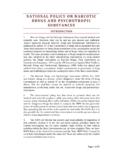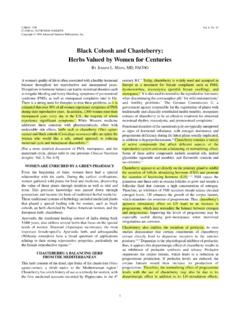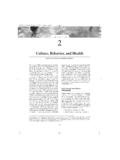Transcription of An Ayurvedic Approach to the use of Cannabis to treat ...
1 An Ayurvedic Approach to the use of Cannabis to treat anxiety By: Danielle Bertoia At (approximately) nearly 5000 years old, Ayurveda is touted as being one of, if not the oldest healing modality on the planet. The word Ayurveda translates from Sanskrit to The Science of Life and is based on the theory that each of us are a unique blend of the 5 elements that make up the known Universe and our planet. Earth, air, fire, water and ether all combine together to create our physical form. When living in harmony with the rhythms of nature and in accordance to our unique constitution, health prevails. When we step outside of our nature by eating foods that are not appropriate, exposing ourselves to outside stressors, and by ignoring the power of our internal knowing, we then leave ourselves vulnerable to dis-ease.
2 Doshic theory reveals to us that these 5 elements then combine with one another to create 3 Doshas. Air and Ether come together to create Vata, Fire and Water to create Pitta and Earth and Water to create Kapha. As we take our first breath upon birth, we settle into our Primary, Secondary and Tertiary doshas, also known as our Prakruti. This becomes our initial blueprint, our Health Touchstone if you will, which we will spend our lifetimes endeavoring to preserve. As time and experience march on, we may begin to experience a distancing from this initial blueprint, a disconnect from our true health, also known as our Vikruti. Outside stress, incorrect food choices, our personal karma and incorrect seasonal diet can all contribute to an imbalanced state within the doshas.
3 By then looking to the qualities of the imbalance we can apply opposing qualities to draw the doshas back into harmony. When looking specifically to anxiety and seeking to treat it medicinally with Cannabis , we must first understand the nature of Vata dosha, as well as it s 5 vayus. Vata dosha is comprised of Air and Ether, is cold, light, dry, mobile, rough, subtle and clear. Vata is responsible for movement, motor function, circulation, respiration and sensory function. Each of these functions are assigned to a particular Vayu, or sub-dosha of Vata. To understand anxiety more clearly from an Ayurvedic perspective, we examine both Vyana and Prana vayu for disturbances. Vayu (Sub-Dosha of Vata) Role in the Body and Mind Vyana (diffusive, circular) Governs circulation, movement.
4 Governs peripheral nervous system. Udana (Upward moving) Governs throat and diaphragm, speech. Prana (Downward and inward moving) Governs respiration, movement of mind, emotions and sense perception. Samana (assimilating, inward) Governs metabolism, digestion, processing of emotions and information. Apana (Downward moving) Governs elimination, menstrual process, release of emotions. Within the Charaka Samhita, an ancient Ayurvedic text, it is said "The body and that which is called the mind are both considered to be abodes of disease, likewise of well-being. The cause of well-being is their harmonious or concordant interaction. 1 From this perspective, we can regard anxiety as being an act of prajnaparada, or a crime against our intellect, expounded up on here from the Charaka Samhita "An unrighteous act done by one who is ignorant and of impaired memory is to be regarded as a volitional transgression (prajnaparadha).
5 2 Another Ayurvedic perspective of acute anxiety is that it is the result of a derangement of Vata dosha, and in particular Vyana and Prana vayu. An excess of air and ether in these channels creates an excess of movement, increasing circulation (Vyana) and therefore resulting in heart palpitations, as well as an increase in the movement of the mind (prana) resulting in circular, cyclical thinking, worry, insomnia and fear. The anxiety and Depression Association of America defines anxiety as follows: Generalized anxiety disorder is characterized by persistent, excessive, and unrealistic worry about everyday things. People with the disorder, which is also referred to as GAD, experience exaggerated worry and tension, often expecting the worst, even when there is no apparent reason for concern.
6 They anticipate disaster and are overly concerned about money, health, family, work, or other issues. GAD is diagnosed when a person worries excessively about a variety of everyday problems for at least 6 months. 3 Affecting almost 7 million people in the United States today, women are seen to be most prone and this condition often exists in conjunction with other psychological conditions, referred to as Though varied, the mainstream allopathic Approach to treating anxiety often lies in psychotropic pharmaceutical applications such as Benzodiazepines, Beta Blockers, Tricyclic Antidepressants, Monoamine Oxidase Inhibitors (MAOIs), Selective Serotonin Re-Uptake Inhibitors (SSRI s) and (SNRIS) Serotonin-Norepinephrine Re-Uptake Inhibitors (SNRI S)5 These medications in their many forms, take action on the brain and nervous system, and in the case of SSRI s which are most often prescribed in cases of GAD (Generalized anxiety Disorder)
7 And depression, they alter the chemical composition of the brain. SSRIs ease depression by affecting naturally occurring chemical messengers (neurotransmitters), which are used to communicate between brain cells. SSRIs block the reabsorption (re-uptake) of the neurotransmitter serotonin in the brain. Changing the balance of serotonin seems to help brain cells send and receive chemical messages, which in turn boosts mood. 6 From an Ayurvedic standpoint, we would seek to treat this condition not from a symptomatic basis but rather from it s roots, which we would view as a vitiated (disturbed) or even deranged Vata dosha. More specifically, we would look to Vyana and Prana vayu as the base of the suffering, creating too much movement in the mind and nervous system. By first assessing the diet, we would ensure that the foods taken in had the qualities necessary to pacify Vata dosha.
8 These would be categorized as heavy, moist, warm and examples could include kitchadi, mung-dahl, root vegetable soups and spiced oatmeals. We would also assess lifestyle practices, often implementing self-care routines such a abhyanga, (application of warmed, doshic-appropriate oils prior to bathing) meditation, and rest to calm the winds of Vata (Prana and Vyana Vayu) and elevate Ojas (our essential life energy). Eliminating stress, increasing joy and actively pursuing ones Dharma can all have a profound and lasting affect on We would also seek herbs with the properties and qualities necessary and appropriate to treat the underlying cause as well as create symptomatic relief for the patient. Though many Ayurvedic herbs can be sited for their benefits in reducing Vata vitiation and quelling the nervous system such as ashwagandha, jatamamsi and shatavari, no Ayurvedic herb can contest with the depth of history and range of abilities associated with Cannabis .
9 Referred to in 1894 by the Indian Hemp Drugs Commission as the penicillin of Ayurveda 8, it was cited in the Atharva Veda as as one the five most sacred plants on Earth and says that a guardian angel resides in its leaves. It also refers to it as a "source of happiness," a "joy-giver" and a liberator . 9 In India, Cannabis was historically used by Brahmins and Sadhus to induce both relaxation and altered states of consciousness, which were beneficial for them in deep meditation. As alcohol was deemed taboo and Tamasic, therefore making it an inappropriate choice for the highest of Castes, these Holy men would utilize this herb in several different forms to suit their needs. The inhaling of smoke from Marijuana Hash was a common practice, as well as the ingestion of a concoction of milk, spices and the leaves of the Cannabis plant, also known as Bhang.
10 This beverage has stood the test of time and is still widely consumed in India during the Holi Festival. The traditional preparation of Bhang would include the following10: Ingredients: 2 cups water 4 cups warm milk 1/2 to 1 teaspoon rosewater 1oz bud 3/4 to 1 cup sugar 2 tablespoons blanched, chopped almonds 1/8 teaspoon garam masala (blend of black pepper, cardamom, caraway seed, clove, cinnamon, bay leaf, nutmeg, mace, cumin seed, coriander, and saffron varies between brands) 1/4 teaspoon ginger powder Consumption of this drink was said to deliver the consumer to spiritual enlightenment by peeling back the layers of consciousness and revealing one s true nature. Regarded as a Schedule 1 drug in the United States, giving it no medicinal value in the eyes of the Government, the use of Cannabis in Western culture is not as widely used in a mainstream setting as we see in India.





